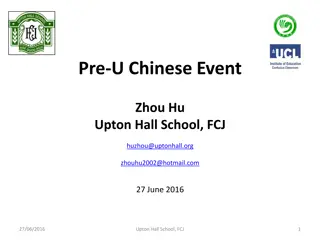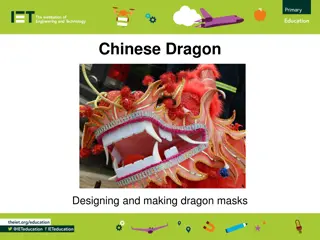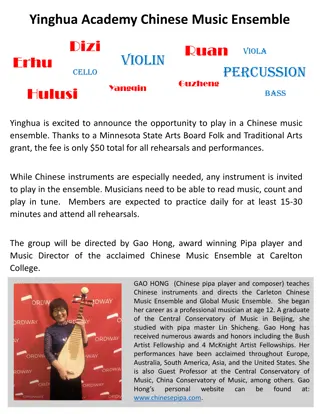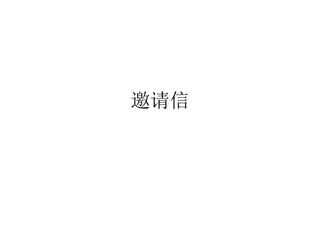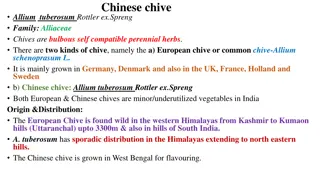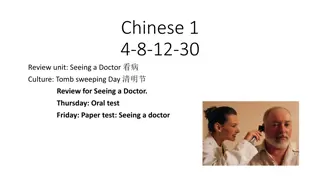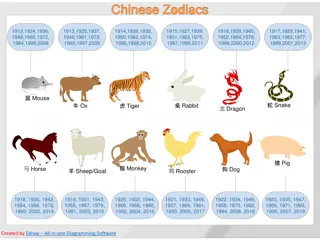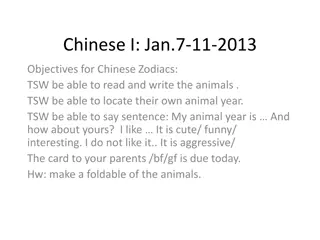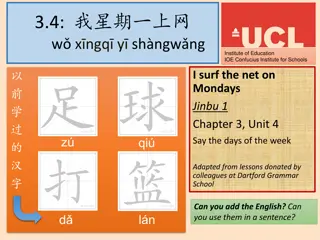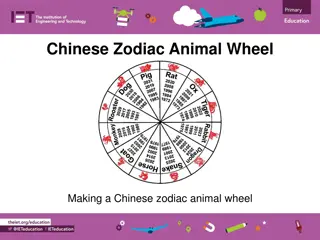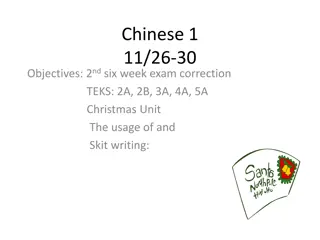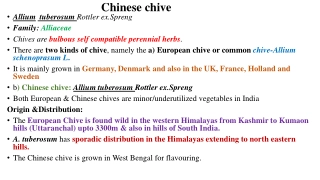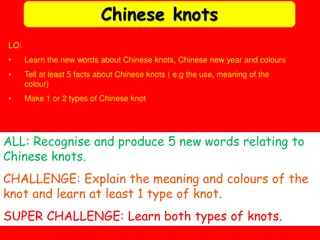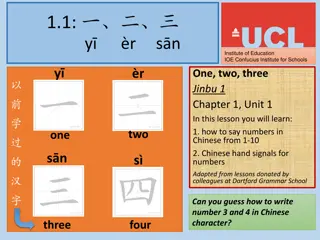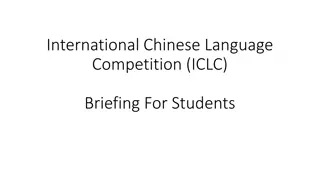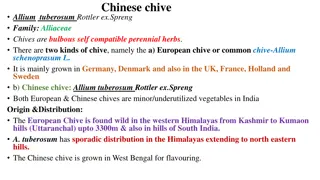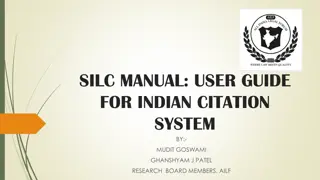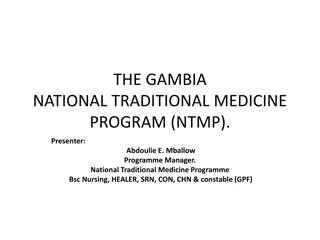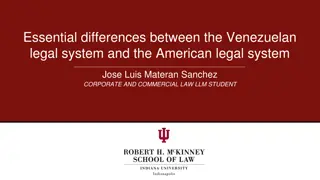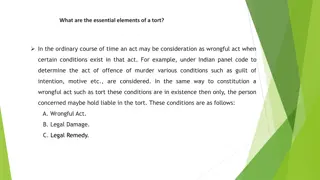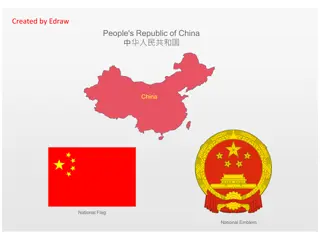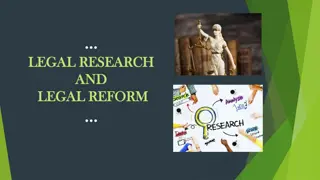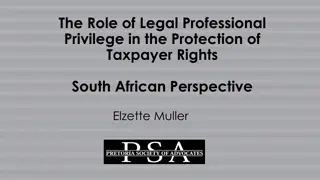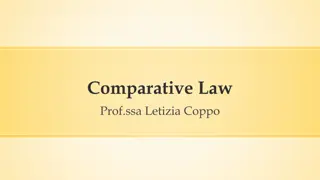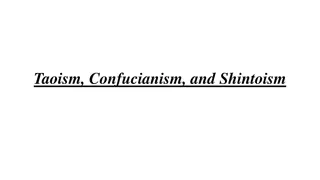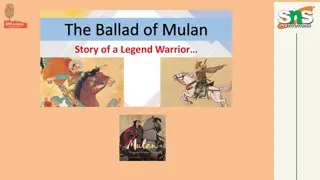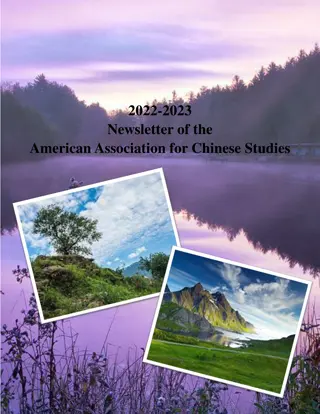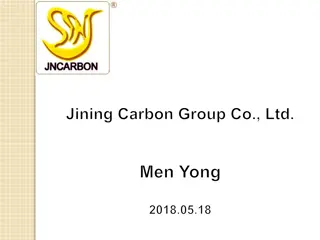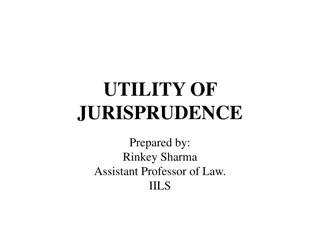Traditional Chinese Legal System: Insights and Practices
Traditional Chinese law is deeply rooted in philosophical principles, particularly Confucian doctrines. The role of law is marginalized, emphasizing harmony and amicable dispute resolution. Judges base decisions on wisdom and experience aligned with Confucian ethics. Legal advisors have low prestige. Legal principles derive from social hierarchy and legislation. Understanding the traditional Chinese legal system sheds light on its unique approach to justice and governance.
Download Presentation

Please find below an Image/Link to download the presentation.
The content on the website is provided AS IS for your information and personal use only. It may not be sold, licensed, or shared on other websites without obtaining consent from the author. Download presentation by click this link. If you encounter any issues during the download, it is possible that the publisher has removed the file from their server.
E N D
Presentation Transcript
Comparative Law Prof.ssa Letizia Coppo Cattedra di Diritto comparato A.A. 2022-2023
The Chinese Legal Tradition
TRADITIONAL CHINESE LAW The marginality of the law The role of the law is marginal; the law has evolved in a position of subordination to philosophical thoughts, namely Confucian doctrines (551-479 b.C.). Citizens must not engage in struggling for their rights, but must be ready to reconcile those rights with the rights of others. The invocation of rights is considered to be an egoist behaviour, something addressing a judge is regarded with suspicion. do be discouraged; 3 Universit LUMSA
TRADITIONAL CHINESE LAW Tung Chung-Shu s doctrine of cosmic harmony Man and the Divine, Heaven and Earth, all living creatures are organic parts of a harmoniously ordered and integrated universe. The most important goal of mankind is to preserve or restore such harmony: no I win, you lose logic, but win-win or joint gain logic. 4 Universit LUMSA
TRADITIONAL CHINESE LAW The approach to litigation In case of a dispute it is amicable resolution that is encouraged; at worse, the intervention of a mediator or an arbitrator. The recourse to a judge is only admitted when the alternative dispute resolution tools have failed. Disputes must be solved on the basis of quing (the circumstances of the case), then on the basis of li (ritual, ceremony, kindness, respect), then on the basis of lii (reason), and, only at the end, on the basis of fa (legislation). 5 Universit LUMSA
TRADITIONAL CHINESE LAW The legal professions The role of the judge: he will decide on the basis of his own experience and wisdom, according to the principles and ethical rules of Confucian philosophical doctrines. He is recruited on the basis of an exam that is not focused on the law, but on philosophical and literary disciplines. The role of legal advisors: they have little prestige as they are there to take advantage of other people s misfortunes, to appease their frustration for having failed the exam to become mandarins. 6 Universit LUMSA
TRADITIONAL CHINESE LAW The sources of law Li = the rules of proper behaviour; their content depend upon the social status of the person to whom they applied, i.e. his status in the family, in the clan, in the neighbourhood, in the official hierarchy and in the State. Fa = legislation 7 Universit LUMSA
TRADITIONAL CHINESE LAW The ideal Confucian Man The person conscious of the natural order of the world who recognises the necessity and purpose of the rules of behaviour expressed by the Li, follows them spontaneously modestly and quietly his own interests in the pursuit of general harmony. and repressed 8 Universit LUMSA
TRADITIONAL CHINESE LAW The archaic Li Precedent to the thoughts of Confucius and the adoption of his doctrine as the official doctrine in III century. It referred in a fist time a religious ritual; then it became a rule of conduct for private and public activities. At the time of the Zhou dynasty, it referred to the costumes of the leading casts and was the pillar of aristocratic education, together with poetry, music and martial arts. 9 Universit LUMSA
TRADITIONAL CHINESE LAW The modern Li With Confucius, the li has been given a new legitimacy as the expression of the moral authority of ancestors and has been put into writing under the form of soft law. The li regulates the succession to the throne and provides for the essential needs of noble law ; it ensured peaceful cohabitation among citizens in conformity with the need of harmony with the cosmic order, on the basis of the social hierarchies expressed by the inequality of rank. 10 Universit LUMSA
TRADITIONAL CHINESE LAW The modern Li The knowledge of the li is strongly encouraged; they are immutable, given that they are not the product of a legislator. Sovereigns are not suggested to promulgate statutes, given that these latter are feared by the people, but diminish in the same time the respect for authority. Once the legislation enacted, the citizens will be able to speculate on its gaps and imperfections, looking for the most elusive and favourable interpretations. The country did not count on the legislation, but rather on the skills and equilibrium of the public officers that were in charge of its application. 11 Universit LUMSA
TRADITIONAL CHINESE LAW The Fa Such source is surrounded by mistrust. If somebody invoked a fa inconsistent with a li, it would be subject to the reprobation of the public opinion. Nevertheless, traditional Chinese law had statutes: above all the fa was used for administrative and criminal law (several codes were promulgated in line with the Confucian philosophy: accurate graduation of penalties on the basis of the victim s and the culprit s status. 12 Universit LUMSA
TRADITIONAL CHINESE LAW Justifcations of the Fa In order to justify the strictness of the fa, it was said that it was a necessary evil applicable to serial criminals, to barbarians and foreigners in general, as those latter could hardly learn and comply with the Chinese rituals and traditions. 13 Universit LUMSA
TRADITIONAL CHINESE LAW Justifcations of the Fa Moreover, it was said that the fa was not applicable to upper classes. In fact, according to Confucius, the rituals (li) do not go down to common people, as well as the sanctions do not climb up to upper classes. Above the class of literate men, the regulation comes spontaneously from music and rituals; below that level, the recourse to the legislation is necessary. Furthermore, the source of fa is the will of the emperor, who is the son of the Sky and has a celestial mandate (which will be revoked if he is not virtuous). The legislation does not come from a God, but it is legitimated by this latter through the celestial mandate. 14 Universit LUMSA
TRADITIONAL CHINESE LAW The social hierarchies, duties and virtues The order of Chinese society is widely committed to the fen, the principle of distributive justice. The placing of an individual in the proper rank ensures, through the variety of roles and treatments, the social harmony that morals pursue. The fen assures the inequality among individuals by regulating the model relationship between the prince and his subject, the father and his children, the husband and his wife, the first son and the others, and so on. 15 Universit LUMSA
TRADITIONAL CHINESE LAW The social hierarchies, duties and virtues At the basis of society, lies the family, united and clan like. The link between the members of the family is assured by the cult of ancestors. The father has a strong power on the children and nephews, that owe him filial pity; the sons have no power on goods and must obey to the family father, also with reference to the choice of the spouse. The family father is personally liable for the conduct of those who are under his authority. The husband has power over his wife; he can have concubines, but of a servant rank. 16 Universit LUMSA
TRADITIONAL CHINESE LAW Political conflicts In 479 b.C. the country was divided by armed conflicts among local princes. The school of Legists prevailed over the Confucian one and imposed its ideology, which was opposed to the one of Confucianism. 17 Universit LUMSA
TRADITIONAL CHINESE LAW Confucians v. Legists Confucians believed that men were inherently good natured and could be brought to virtue by education and by the example of the rulers. Legists believed that men were inherently bad and selfish, therefore needed strict discipline. 18 Universit LUMSA
TRADITIONAL CHINESE LAW Confucians v. Legists Confucians believed that all men should be treated according to their status, i.e. their place in the world. Legists believed that all men are equal before the law and that the proper behaviour should be taught through severe criminal sanctions. 19 Universit LUMSA
TRADITIONAL CHINESE LAW The Ts in dynasty and the triumph of Legists (221 b.C.) The dynasty took power and established a strong centralised administration, statutes and imposed fearful burdens on the population. enacted draconian The dynasty pursued Confucian followers and burnt their writings. 20 Universit LUMSA
TRADITIONAL CHINESE LAW The Han dynasty and the re-rise of Confucianism (206 b.C.) The Han dynasty took power and restored Confucianism as the official ideology of the Empire. The ideology was spread across the country by travelling disciples. Reading of the Confucian classics became crucial for education. 21 Universit LUMSA
TRADITIONAL CHINESE LAW The Han dynasty and the re-rise of Confucianism (206 b.C.) A state examination was introduced for every step of the carrier path in the mandarinate, of which the knowledge of Confucianism was a paramount part. This contributed to the birth of a class of highly educated imperial magistrates, crucial for the administrative organisation. 22 Universit LUMSA
TRADITIONAL CHINESE LAW Legislation the Fa Confucians necessary evil. Several codes were enacted, most of all to regulate criminal and administrative law. admitted that legislation was a The codes reflected the Confucian ideals: e.g. accurate gradation of penalties in relation to the status of the victim and the guilty. 23 Universit LUMSA
TRADITIONAL CHINESE LAW The judiciary State courts held by imperial officers in the capital cities of the provinces or regions: not often used, also because procedures were long and expensive and judges had the reputation of being lazy and corrupt. At a local level, the most prominent or wise persons in the community served as conciliators. 24 Universit LUMSA
MODERN CHINESE LAW The connection with the Western world In XIX century the contacts between China and the Western world have been intensified and this lead the Chinese empire to reform traditional codes with the help of Chinese jurists educated in Europe and of Japanese jurists. Such efforts resulted into the translation of western models. In 1910 a new code was promulgated, which refused cruel punishments such as fustigation, decriminalised family law, the law of goods and the law of successions. 25 Universit LUMSA
MODERN CHINESE LAW The first Republic In 1911 the last emperor of China abdicated in favour of the Republic. This latter was articulated in 5 separate powers, matching with 5 organs of the apparatus (Yuan): 1. Legislative power 2. Executive power 3. Judiciary power 4. Control power 5. Exam power 26 Universit LUMSA
MODERN CHINESE LAW The first Republic The government, supported by the Guomindang (the nationalist party), promulgated 6 codes: 1. Constitution (1931, 1936, 1947) 2. Civil code (1929-1930, German, Japanese and Swiss models) 3. Code of commerce 4. Criminal code (1912, 1928, 1935, modelled on the Italian pen. cod.); 5. Civil procedure code 6. Criminal procedure code To the list we must add rural laws, company law; credit instruments; maritime trade; insurance law. 27 Universit LUMSA
TRADITIONAL CHINESE LAW The main features Precedents were a source of law The judicial system was organised on 3 levels The functions of the prosecution were separated from those of judges Judges started being a category of professionals There was no jury 28 Universit LUMSA
TRADITIONAL CHINESE LAW The main features The new statutes have introduced: the concept of subjective right the principle of gender equality in successions the prohibition of analogy in criminal law procedural safeguards a system of administrative justice the abolition of torture 29 Universit LUMSA
TRADITIONAL CHINESE LAW The main features Though, codes have remained stranger to the Chinese tradition and have never deeply penetrated into the life of Chinese people (except in the towns of the coast). The codes have been applied in a very flexible way by the judges, who used to decide on the basis of equity rather than on a strictly legal basis. The codes, as well as the other statutes, were abrogated in 1949 (except in Taiwan) after the raise of the communist party and the foundation of the People s Republic of China. 30 Universit LUMSA
TRADITIONAL CHINESE LAW The Peoples Republic of China In September 1949 the communist party promulgated a Constitution (common programme) in 60 articles, that founded the People s Republic of China, an alleged State of popular democracy. The pillar of the system was the proclamation of the supremacy of the working class, made of labourers and peasants. All the citizens were entitled to vote for the elections and to other political rights. The State and cooperative enterprise lied at the centre of the economy and owned all the means of production. The common programme was hiding a crucial element: the country was totally subject to the party and the actions of this latter were without appeal. 31 Universit LUMSA
TRADITIONAL CHINESE LAW The Peoples Republic of China The revolution implanted an absolute power, managed by the top of the party according to the following hierarchy: secretariat, political office, central committee. The political will of the party (and its execution through the internal bureaucratic hierarchy) was enough to regulate Chinese public life. No need to have a system of statutes: the will of the party had the rank of written, positive, ideological law, applied in a flexible way, with a significant margin of discretion, if not whim, by the party officers. The private life of people rested on a popular self-managed tradition, more or less influenced by the contact with the Western world. Prior law had been abrogated, but people kept on applying it, while waiting for alternative solutions. 32 Universit LUMSA
TRADITIONAL CHINESE LAW The Peoples Republic of China The regime was grounded on the repression of all deviations and resistances, which imposed a heavy recourse to legal remedies: rules on the ownership of the means of production, of the products, of the profits derived from the sale of the products; and on the salary of workers. 33 Universit LUMSA
TRADITIONAL CHINESE LAW The Peoples Republic of China The model was that of Russian socialist economy: law can be qualified as socialist whenever it deprives individuals of the means of production and collectivize them. Thus, the socialist model revolves around the distinction between means of production (land, fixed and circulating capitals ) and consumption goods, i.e. goods that serve to the immediate fulfilment of human needs (food, clothes ). 34 Universit LUMSA
TRADITIONAL CHINESE LAW The Peoples Republic of China As a matter of principle, means of production must belong to the State (socialist State ownership). Their management is committed to State enterprises provided with legal personality and established for that specific purpose. The main exception are agricultural means, the permanent and free use of which has been granted to cooperatives of peasants (socialist cooperative ownership). 35 Universit LUMSA
TRADITIONAL CHINESE LAW The Peoples Republic of China The goods produced by socialist cooperatives were individual property of the peasants. Houses could be the object of individual property, but the widespread trend was that even the house was State property and the inhabitants were just tenants. Multi- families tenancies were also encouraged as it was a widespread belief that individual families segregate persons from the rest of society. 36 Universit LUMSA
TRADITIONAL CHINESE LAW The Peoples Republic of China 2 alternatives: Identifying the legal norm with the pure political will of the party, transmitted to those who are in charge of executing it through the press and the internal acts of the administration all that ensured by an apparatus of dissuasion based on political propaganda (which clarifies what is appreciated by the party) and political-legal sanction (the consequences of deviances in terms of career or the confinement in work and re-education camps) Committing to formalized legal norms promulgated by the State and applied by officers and judges. 37 Universit LUMSA
TRADITIONAL CHINESE LAW The Peoples Republic of China The Chinese solution has been a compromise between the two: on one side it could have chosen the first option, following the soviet model, as the Chinese are accustomed by tradition to do without norms; on the other side, such absence of norms recalled the Confucian tradition, which was the expression of an immobilism and social elitism inconsistent with the socialist ideals. The compromise has been the adoption of the soviet model, but formalised through the promulgation of statutes, namely several codes and a constitution, imitating the ones promulgated by Stalin. This model has lasted until 1976. Afterword, a counter-trend, a reaction against the system, was developed. 38 Universit LUMSA
Prof.ssa Letizia Coppo Email: l.coppo1@lumsa.it lcoppo@univ-catholyon.fr





